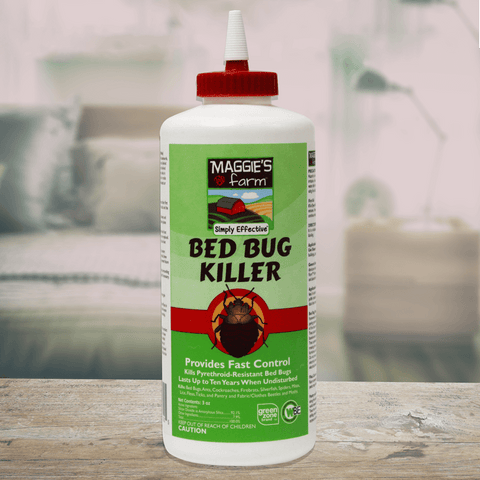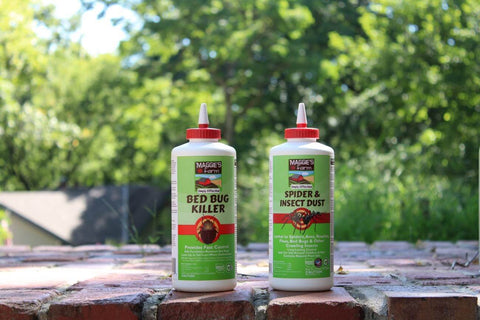When bed bugs take up residence in your home, it’s never any fun. These pests feed on humans and invade in large numbers. Once they’ve settled down, it can be tricky to get them to leave. We’ve gathered information to help you get rid of bed bugs in your home.
How to Identify Bed Bugs

Adult bed bugs are flat and round. These reddish-brown pests are small, about ¼ʺ. When bed bugs feed, they enlarge and have a stronger reddish hue. Nymphs are even smaller and are a white or light brown color. Bed bug eggs are tiny and white, and they can resemble a grain of rice.
How Do You Get Bed Bugs?

Bed bugs are sneaky and can easily find their way into your home. Check out how bed bugs can infest your space.
- Travel: Bed bugs are often found in hotels because they can find food sources without too much trouble. When you travel, bed bugs slip into luggage and bags. They’ll remain hidden on your items and end up coming home with you.
- Furniture: Bed bugs aren’t opposed to hiding in furniture. Secondhand pieces and new items can be infested with these pests. It’s important to check for signs of bed bugs before bringing a piece into your home.
- Your Neighbors: Apartments and dorm rooms are excellent hiding places for bed bugs. These tiny bugs can travel between rooms, causing infestations to spread quickly.
- Public Transportation: Though it’s less common, bed bugs can spread through public transportation. They hide in upholstered seats and hitch a ride on you and your items.
Signs You Have Bed Bugs

Identifying a bed bug infestation quickly will help to prevent the problem from getting out of control. Check out a few indicators that bed bugs are living in your home.
- Physical Bed Bug Sightings: It’s important to keep your eyes open for bed bugs and their eggs. They can be spotted on your bed, bedding, and any small crevice they can squeeze into.
- Stains on Bed: Rusty colored stains can be a sign of bed bugs. When crushed, they leave behind these markings. You may also notice darker spots that are bed bug droppings. These may bleed on the fabric like a marker.
- Odor: When dealing with large infestations, an unpleasant odor may occur. It’s usually described as a musty scent.
- Bed Bug Bites: When bed bugs bite, it may result in red, itchy bumps. They are often clustered together and found on areas exposed while sleeping. It’s important to remember that other bug bites can resemble bed bug bites, so this isn’t always the best sign of an infestation.
Where to Look for Bed Bugs

Bed bugs are small and can hide in a variety of places. Check out a few common bed bug hiding spots.
- Your Bed: The most common place to find these pests is your bed. Check your mattress, bedding, headboard, and bed frames.
- Furniture: Any furniture near your bed could be infested with bed bugs. Be sure to look inside nightstands and dressers. They can also slip behind wall décor and other items in your room.
- Floor: Bed bugs can hide in carpet, rugs, and on baseboards and molding.
- Electrical Outlets: These pests can slip under electrical plates. If you suspect an infestation, don’t forget to check here.
Why is it Difficult to Get Rid of Bed Bugs?

Bed bugs aren’t always the easiest pest to remove from your home. Knowing why bed bugs are difficult to control can help when trying to eliminate an infestation.
- Bed Bugs Are Excellent Hiders: Bed bugs are tiny and flat, which makes it easy for them to hide. They can squeeze into cracks, crevices, and other protected areas of your home.
- Bed Bugs Multiply Quickly: Bed bugs can lay up to five eggs each day and 500 in their lifetime. Eggs hatch in about 2 weeks. This means that infestations can spread quickly, making it more difficult to get rid of these pests.
- Resistance to Some Pest Control Products: Some bed bugs have developed resistance and are unaffected by many pest control products on the market.
How to Prepare for Bed Bug Treatment

Before you use a bed bug product, there’s some prep work to be done. Following these steps will help make your pest control efforts effective.
- Eliminate Clutter: Clutter is a bed bug’s best friend. It provides them with hiding places, making it harder to eliminate an infestation.
- Clean Under Your Bed: Remove any items that are stored under the bed. This will also help to eliminate potential hiding spots for bed bugs.
- Treat with Heat: Washing any infested bedding will kill live bed bugs, but heat is needed to kill eggs. After washing, place bedding in the dryer on a high heat setting for at least 15 minutes. You’ll also want to place items that can’t be washed, like stuffed animals, heavy coats, and throw pillows, in the dryer.
- Vacuum: Vacuuming can help to get rid of hidden bed bugs and eggs. Make sure to vacuum the carpet, rugs, floor, mattress, box spring, upholstered furniture, and baseboards. Remove the bag, seal it, and place it in a trash can outside.

Why You Should Use Maggie’s Farm Bed Bug Killer

When choosing a bed bug product, it’s important to find the right fit for you. Check out why our Bed Bug Killer can help keep your home free of bed bugs.
- Independent research has proven Maggie’s Farm Bed Bug Killer to be the most effective bed bug control product on the market.
- It uses an engineered silica dust composition that works by clinging to bed bugs, destroying their waxy cuticles and drying out their body. It literally “sucks the life” out of bed bugs! When applied properly, it will provide fast-acting and long-lasting control.
- It kills adult bed bugs and nymphs, including the ones that are resistant to the most commonly used synthetic chemical pesticides.
- Maggie’s Farm Bed Bug Killer is odorless, non-staining, and easy to apply. It also has very low toxicity, meaning that it has low potential for any harmful effects on people or pets.
- It can continue working effectively for up to 10 years when left undisturbed.
How to Get Rid of Bed Bugs

After prepping for bed bug treatment, it’s time to treat your space. Check out a few tips to eliminate a bed bug infestation.
- Follow Directions on Label: Remember to read and always follow the instructions on the bottle. This will give you detailed instructions on how and where to apply Bed Bug Killer dust.
- Use the Right Amount: A little bit of dust goes a long way. It’s very light, which makes it easier to apply in hard-to-reach places. Over-applying the dust won’t make it more effective, it will only leave a heavy and messy white dust residue that bed bugs tend to avoid. Apply a light, visible film. 2 oz. of Bed Bug Killer is recommended to cover 100 sq. ft.
- Use a Brush: We recommend using a small to medium-sized paint or craft brush to apply dust. A 1-1.5 inch brush works best. You want the brush to be small enough to fit into crevices.
- Wear Gloves: Wear rubber gloves when applying Bed Bug Killer. The dust can make your skin feel dry.
Where to Apply Bed Bug Killer

Applying Bed Bug Killer thoroughly will help ensure you get rid of bed bugs. Here are a few areas you’ll want to treat.
- Your Bed: Remove all bedding and take the bed apart. These pests can hide in bed frame corners, nooks, and inside the frame, screw holes, and wooden slats. Apply a light visible film of dust to the interior framework of the bed rails, headboards, and footboards. Don’t forget to treat screw holes and bed frame joints.
- Your Box Spring: Lightly apply the dust to all the seams around the box spring. Then, turn the box spring upside-down, and using the squeeze bottle, find or make a small opening in the dust cover to gain access to the interior of the box spring. Apply several puffs inside the box spring.
- Your Mattress: Brush along all the seams on the outer edge of the mattress. Be sure to apply on both sides if your mattress is double-sided. Don’t forget to apply dust to any tufts and folds.
- Furniture: Upholstered furniture will also need to be examined and treated for bed bugs. Remove the cushions and apply dust to seams, folds, and tufts. It’s important to treat all sides of the piece and cracks or joints found on furniture.
- Baseboards & Electrical Outlets: Using your brush, apply dust to cracks and crevices along baseboards. Treat wall voids near the bed by removing electrical switch plate covers to gain access. Using a squeeze bottle, apply a light dust, about ¼ of an oz., to each accessible void. Don’t apply directly into electrical boxes.
- Floors: If you notice bed bug activity in the carpet or rug, use a squeeze bottle to apply dust on the floor near and under the bed. Use a broom to work the dust into the carpet or rug.
While bed bugs can be tricky pests to eliminate, there are steps you can take for a bug-free home. If bed bugs and other pests have invaded, we’re here to help! Check out our Maggie’s Farm Simply Effective™ Pest Control products for a more environmentally and family-friendly solution when used as directed.
